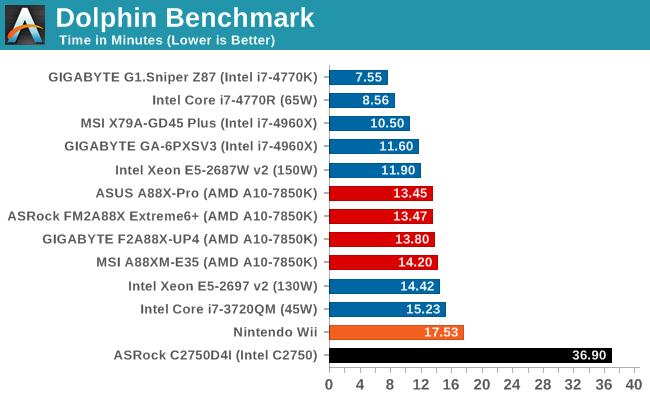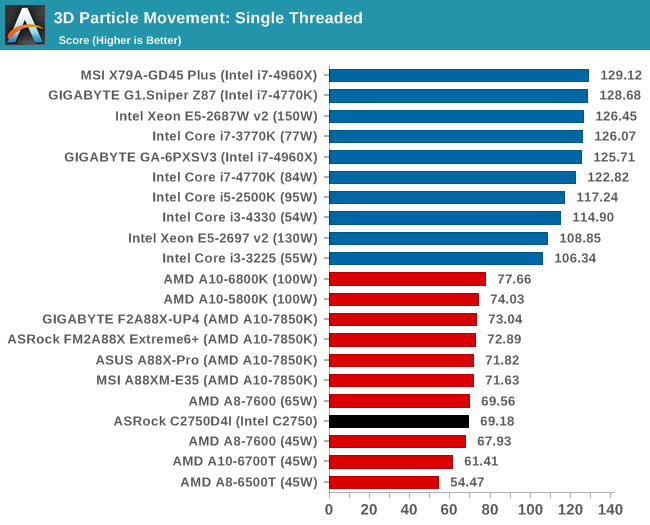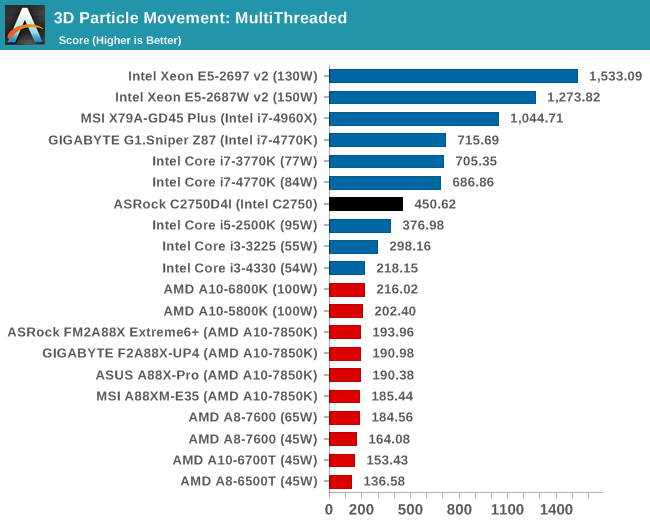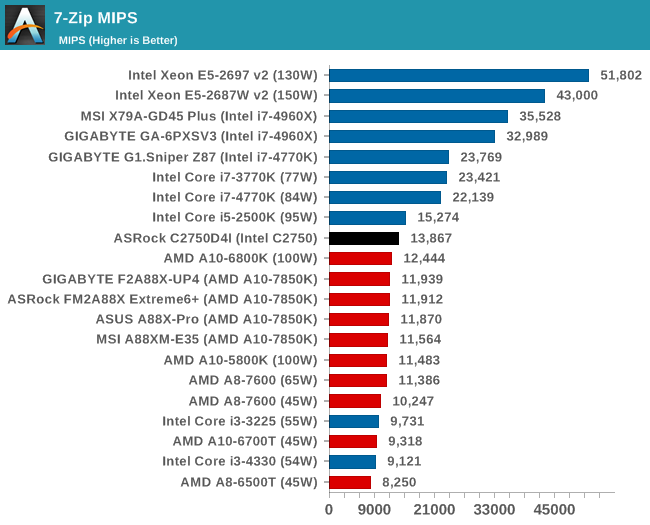ASRock Rack C2750D4I Review: A Storage Motherboard with Management
by Ian Cutress on April 29, 2014 9:00 AM EST- Posted in
- Motherboards
- Storage
- Atom
- ASRock
- Silvermont
- Enterprise
- server
- Avoton
Scientific and Synthetic Benchmarks
2D to 3D Rendering –Agisoft PhotoScan v1.0: link
Agisoft Photoscan creates 3D models from 2D images, a process which is very computationally expensive. The algorithm is split into four distinct phases, and different phases of the model reconstruction require either fast memory, fast IPC, more cores, or even OpenCL compute devices to hand. Agisoft supplied us with a special version of the software to script the process, where we take 50 images of a stately home and convert it into a medium quality model. This benchmark typically takes around 15-20 minutes on a high end PC on the CPU alone, with GPUs reducing the time.

Console Emulation –Dolphin Benchmark: link
At the start of 2014 I was emailed with a link to a new emulation benchmark based on the Dolphin Emulator. The issue with emulators tends to be two-fold: game licensing and raw CPU power required for the emulation. As a result, many emulators are often bound by single thread CPU performance, and general reports tended to suggest that Haswell provided a significant post to emulator performance. This benchmark runs a Wii program that raytraces a complex 3D scene inside the Dolphin Wii emulator. Performance on this benchmark is a good proxy of the speed of Dolphin CPU emulation, which is an intensive single core task using most aspects of a CPU. Results are given in minutes, where the Wii itself scores 17.53; meaning that anything above this is faster than an actual Wii for processing Wii code, albeit emulated.

Emulation is clearly not a target for Avoton.
Point Calculations – 3D Movement Algorithm Test: link
3DPM is a self-penned benchmark, taking basic 3D movement algorithms used in Brownian Motion simulations and testing them for speed. High floating point performance, MHz and IPC wins in the single thread version, whereas the multithread version has to handle the threads and loves more cores.


As the 3DPM test abuses the ability for a CPU to dispatch threads and FP calculations, Intel have historically been good here. The CPU battles with AMD in single threaded, but the 8 cores allows software to exploit parallelism in this manner.
Encryption –TrueCrypt v0.7.1a: link
TrueCrypt is an off the shelf open source encryption tool for files and folders. For our test we run the benchmark mode using a 1GB buffer and take the mean result from AES encryption.

For AES software encryption, the Avoton platform enjoys the 8 cores but suffers from a lack of hardware acceleration, putting it in the region of the AMD CPUs.
Synthetic – 7-Zip 9.2: link
As an open source compression tool, 7-Zip is a popular tool for making sets of files easier to handle and transfer. The software offers up its own benchmark, to which we report the result.











85 Comments
View All Comments
SuperSpy00bob - Monday, May 5, 2014 - link
Oops. I it's only mentioned in the spec chart, not in the article itself. It seemed like a glaring omission.JBVertexx - Wednesday, April 30, 2014 - link
For home use, I don't know why you would pay so much for such a low-end processor. For $40 more you can have this (http://www.newegg.com/Product/Product.aspx?Item=N8... plus a Xeon E3-1230v3.I'm running a home server on an E3-1230v2 (even cheaper), and it handles storage, Plex transcoding to everyone's devices, offloaded Blu-Ray Rip transcoding, and hosts several VMs running minecraft servers for the kids. No way you could do all that with this board.
djb61 - Wednesday, April 30, 2014 - link
I've actually built a storage box recently using a fairly similar setup for a home NAS. I used the supermicro C2750 board however and added an IBM M1015 SAS card flashed to an IT mode LSI 9211-8i firmware for the disks. Then I have 8x4TB WD Reds in the Silverstone DS380.I'm still doing initial stress testing to make sure there are no dodgy disks etc currently so I can't comment about actual day to day use of such a system yet.
One thing I did notice with the DS380 is there appears to be a minor design flaw in the trays/backplane which is visible in the pictures here also.
The HDD trays have a clear perspex light guide built into the right side of them which allows an activity LED for the port on the backplane to illuminate to the front of the tray. This is the little square notch visible on the right hand side of the trays in the pictures here. However the activity light for the 4th bay from the top (5th from the bottom) doesn't illuminate on the tray properly despite it clearly lighting up on the backplane board. If you look at the picture of the backplane board and note the component labelled LED5 and its position relevant to the connector SATA13 and compare this to all the other LED and SATA components. The relative positioning on this bay is different and therefore is not aligned with the light guide on the HDD tray. I'm not quite sure how they managed to let that slip through the design stage but maybe Anandtech could feed it back to Silverstone.
azazel1024 - Thursday, May 1, 2014 - link
Why would you test power consumption in that config? It tells you nothing as it isn't remotely comparable to what it actually uses by itself or how you'd normally be using it.jwcalla - Thursday, May 1, 2014 - link
People are reporting that ASRock is pretty much treating this as a Windows-only board. If you have problems on other OSes, don't expect support from them.And with a Marvell controller... we can expect problems.
Krautmaster - Friday, May 2, 2014 - link
well, be bechmarks are a mess for a server board like this. Why not any VM benches or Storage Benches ...I used that board for Storage Tiering in Server 2013 R2 with 3x4Tb + 4x2 TB + 2x256GB SSDs see here http://www.computerbase.de/forum/showthread.php?t=...
Bronek - Sunday, May 4, 2014 - link
It's worth saying that this motherboard supports up to 64GB of ECC memory. Thanks Ian, I think you just identified parts I will need for my FreeNAS build :)copilusntil0p@ - Monday, May 5, 2014 - link
1. It's interesting how the used the PLX chipset givint tha fact that the Avoton is a SoC ant tha NICs ar integrated in it. 2. To those yelling "drop BMC": this board is not for you; don't judge it for what is not. 3. I've been in the situation to chose between this board and a Supermicro A1SRi-2758F for a home server. I've choose the latter and paired it with an HP P400 with 512MB cache and BBU (50$ on e-bay). So now I have a preety decent box with 5 gigabit interfeces, IPMI via AST2400 and 14 SATA ports (6 onboard from the SoC and eight SAS-to-SATA from the HP controller backed-up by 512MB of DDR2 cache). I've attached one Samsung 840 Pro SSD to one of the SATA 3 ports for SSD caching on ESXi. An givving the fact that the board comes from a manufacturer with greater experience in the server market, has an upgraded BMC controller, management software, wider accessory range (cases, controllers etc), has all LAN ports available, four USB 3 ports (one is directly attached to the board).LastQuark - Monday, May 5, 2014 - link
Interesting build. I thought about this route as well and since I will be using KVM, the ASRock solution is good enough for me while keeping the part count as a minimal. Have I gone to ESXi and need more ethernet ports, that Supermicro + HP solution is the way to go with only a slight penalty in power savings.dzezik - Thursday, May 8, 2014 - link
What a stupid review. Find nothing about storage performance. You used storage motherboard and stroge enclosure to test gaming performance. Who is using his NAS server for gaming?